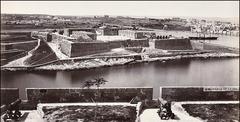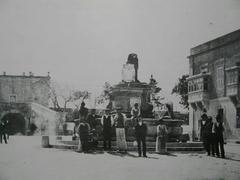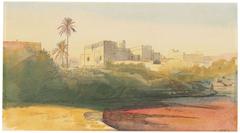
Empire Stadium Gżira Malta: Visiting Hours, Tickets, and Historical Sites Guide
Date: 04/07/2025
Introduction
Empire Stadium in Gżira, Malta, stands as a powerful symbol of the island’s sporting and cultural heritage. Established in 1922 and rebuilt in 1933, the stadium became the beating heart of Maltese football, hosting pivotal matches and serving as a vibrant community hub for decades. Although it ceased operations in 1981 and has since fallen into disrepair, Empire Stadium remains an evocative landmark for history enthusiasts, sports fans, and travelers keen to discover Malta’s unique past. This comprehensive guide explores the stadium’s rich legacy, practical visitor information, accessibility, and nearby attractions, ensuring you get the most out of your visit to this historic site (Times of Malta, iLand Malta, Grumpy Camel).
Contents
- Introduction
- History of Empire Stadium
- Origins & Early Development (1922–1933)
- The Golden Era (1933–1940)
- Wartime Challenges & Post-War Revival
- Technological Innovations & Major Events
- Cultural Significance & Community Impact
- Decline & Legacy
- Visiting Empire Stadium
- Current Status & Accessibility
- Visiting Hours & Ticket Information
- Getting There
- What to Expect On Site
- Safety & Practical Tips
- Nearby Gżira Attractions
- Frequently Asked Questions (FAQs)
- Conclusion & Recommendations
- Sources
History of Empire Stadium
Origins & Early Development (1922–1933)
Empire Stadium, originally known as Empire Sports Ground, opened in 1922, quickly becoming Malta’s first major sporting venue. Initially serving as a dedicated football ground, it played a crucial role in the rise of organized sports on the island, hosting league matches, cup finals, and emerging as a focal point for the community. By the early 1930s, the ground had deteriorated, prompting Carmelo Scicluna and a British syndicate to invest in extensive renovations. The old ground was demolished in 1933, making way for a modern, larger stadium that boasted increased capacity and contemporary amenities, solidifying its status as one of the region’s most advanced venues (Times of Malta).
The Golden Era (1933–1940)
The new Empire Stadium opened on December 24, 1933, launching a golden era for Maltese football and sports. The stadium hosted the Christmas Tourney and attracted prestigious European clubs, raising Malta’s sporting profile. With its modern facilities, the venue became synonymous with national pride, uniting locals for key matches and establishing a robust football culture (Times of Malta).
Wartime Challenges & Post-War Revival
World War II brought interruptions, with the stadium suffering damage and a temporary halt to competitive events. Post-war, the community rallied to restore and upgrade the facilities. The 1950–51 season saw major improvements, including new stands and updated dressing rooms, reigniting the stadium’s role as Malta’s sporting epicenter (Times of Malta).
Technological Innovations & Major Events
Empire Stadium was the first in Malta to host a football match under artificial lights on March 6, 1951, a pioneering move at the time. Over subsequent decades, the venue hosted league matches, cup finals, and international fixtures, often drawing crowds far exceeding its official capacity. Notably, the 1971 Nations Cup qualifier between Malta and England saw further enhancements to the pitch and spectator facilities (Times of Malta).
Cultural Significance & Community Impact
Beyond sports, Empire Stadium became a cultural landmark—hosting national celebrations, public rallies, and cultural events, especially during the independence movement. It fostered unity and national pride, serving as a gathering place for people from all walks of life. The stadium remains woven into Maltese collective memory, often referenced in oral histories and local folklore (Times of Malta).
Decline & Legacy
With the construction of Ta’ Qali National Stadium in 1981, Empire Stadium was retired and gradually abandoned. Today, its ruins stand as a testament to nearly six decades of sporting and social history, a poignant reminder of Malta’s evolution and enduring communal spirit (iLand Malta, Grumpy Camel).
Visiting Empire Stadium
Current Status & Accessibility
Empire Stadium is now unmanaged and in a state of disrepair. The site on Triq D’Argens, Gżira, is open to the elements, with remnants of the grandstand and entrance visible, but the pitch and seating areas are overgrown and unsafe. There are no official visitor facilities, guided tours, or interpretive signage (Europlan Online; Wikipedia).
- Accessibility: The stadium is not wheelchair accessible due to uneven ground and lack of pathways. Exercise caution if exploring the perimeter.
Visiting Hours & Ticket Information
- Visiting Hours: There are no formal visiting hours. The site is accessible year-round during daylight.
- Ticketing: No tickets or entry fees are required, as the site is not an operational venue.
- Guided Tours: No regular tours are available, but local tour operators occasionally offer cultural walks that may include the site (Grumpy Camel).
Getting There
- Location: Triq D’Argens, Gżira, Malta, adjacent to Sliema and near Valletta.
- Public Transport: Multiple bus routes connect Gżira to Valletta, Sliema, and other towns (Mapcarta). Bus stops are within a 5-minute walk.
- Parking: Limited and often challenging; public transport or taxis are recommended.
What to Expect On Site
- Atmosphere: Visitors can walk the perimeter and view the remains of the grandstand and entrances. Interior access is generally restricted for safety.
- Facilities: None—no restrooms, shops, or staff present.
- Photography: The ruins provide atmospheric backdrops, especially in early morning or late afternoon light.
- Safety: Wear sturdy footwear and avoid unstable structures or climbing on ruins.
Safety & Practical Tips
- Best Time to Visit: Daylight hours, year-round. Summer offers long days, but bring water and sun protection (Malta Info Guide).
- Respect: Do not litter or damage the fragile remains.
- Engage Locals: Nearby cafés and businesses are good places to hear personal stories about the stadium.
Nearby Gżira Attractions
Empire Stadium’s central location makes it a convenient starting point for exploring Gżira and neighboring areas:
- Manoel Island & Fort Manoel: 18th-century fortifications and scenic walks.
- Orpheum Theatre, Sliema: Renowned Art Deco venue.
- St Joseph’s Church, Msida: Historic Baroque church.
- Balluta Bay & Kiosk, St Julian’s: Picturesque seaside area.
- Gżira Parish Church: Architectural and religious landmark.
All sites are within a 10–20 minute walk (Mapcarta, Trek Zone).
Frequently Asked Questions (FAQs)
Is Empire Stadium open to visitors?
Yes, the site is accessible year-round during daylight hours, but is not managed or officially open.
Are tickets required?
No tickets or entry fees are required.
Are there guided tours or on-site information?
No official tours or interpretive signage are available.
Is the site wheelchair accessible?
No, the terrain is uneven and not suitable for wheelchairs.
Is it safe to visit?
Take usual precautions; avoid unstable structures and visit during daylight.
Are there any restoration plans?
No official restoration projects are currently underway (Local Gyms & Fitness).
Conclusion & Recommendations
Empire Stadium in Gżira remains an enduring testament to Malta’s sporting heritage and communal spirit. While its physical state reflects decades of neglect, its legacy continues to inspire locals and visitors alike. The site offers a unique, contemplative experience for those interested in Maltese culture, football history, or urban exploration. Plan your visit during daylight, combine it with a stroll through Gżira’s historical sites, and treat the area with respect to preserve its story for future generations.
For additional cultural experiences, consult resources such as the Gżira Local Council and Visit Malta Official Tourism. For the latest updates and curated guides, download the Audiala app and follow Maltese heritage channels on social media.
Sources
- Times of Malta – The Empire Stadium: A Trip Down Memory Lane
- iLand Malta – Empire Stadium Heritage
- Grumpy Camel – Malta Football History
- Gżira Local Council
- Visit Malta Official Tourism
- Europlan Online – Empire Stadium
- Wikipedia – Empire Stadium (Gżira)
- Local Gyms & Fitness – Empire Stadium
- Mapcarta – Empire Stadium
- Trek Zone – Empire Stadium
- Malta Info Guide – Activities in Malta



